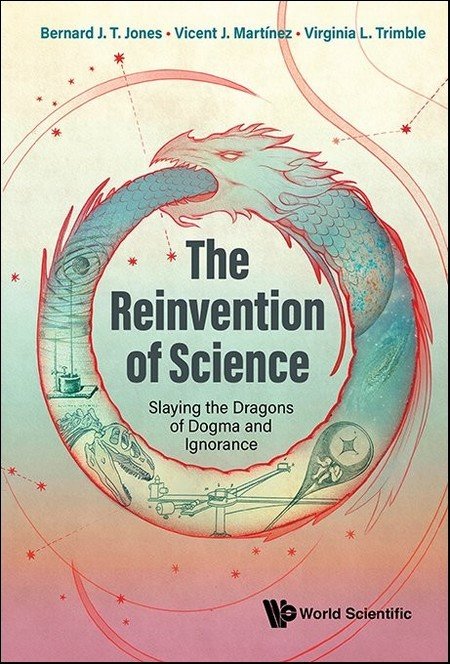The Reinvention of Science: Slaying the Dragons of Dogma and Ignorance
Many books have been published on the history of science. Each one provides a specific insight, and together they offer a fairly complete overview of the evolution of a substantial part of the intellectual heritage of mankind. The book I will review in these lines is, from that point of view, one more. One more book to enrich the vision we have of the knowledge of nature and the way in which that knowledge has been produced.
I started reading it with that idea in mind. However, from the very first pages I realized that this one was something different. To begin with, its authors have not had the purpose of making an exhaustive review of all scientific disciplines. They have addressed a particular aspect of scientific progress and, by virtue of this objective, concentrated their efforts on certain topics or fields of knowledge, without aiming to offer a general overview of the natural sciences.
The object of the book is metaphorically reflected in its subtitle: “Slaying the Dragons of Dogma and Ignorance”. I will refer to the main title later. The subtitle refers to the legend that appears in the Globe of Hunt-Lenox (1503-1507), HC SVNT DRACONES (hic sunt dracones, ‘here be dragons’), following the medieval tradition of mentioning the presence of mythical creatures in the periphery of the known world, as a way of expressing the ignorance about those marginal areas and the dangers –real or imagined– that awaited those who dared to venture through them.

The authors resort to the metaphor of dragons, imaginary beings, to refer to entities whose existence has been postulated throughout the history of knowledge, to offer a satisfactory explanation of the real world that, with the passage of time, have been shown to be unnecessary, false or erroneous. This is the reason for the will expressed in the subtitle to “kill” these creatures. Following the metaphor, the advance of science would have been eliminating these entities to be replaced by more satisfactory explanations.
Here be dragons
The first dragon to which the authors refer is the luminiferous ether, that invisible substance to which the property of transmitting light was attributed and whose existence could not be proved by Michelson and Morley in one of the most famous experiments in the history of physics. That one is followed by a few more dragons in the book, although not all the topics discussed refer to some imaginary entity. What all the topics do have in common is a description of the course of discoveries, proposals, controversies and, in some cases, even the (human) miseries that have marked the advance of knowledge.
Most of the chapters deal with Astronomy, Cosmology and Physics, which seems logical given the disciplinary affiliations of the authors. But they also deal with issues from other disciplines, such as continental drift and plate tectonics (Geology), the homunculus that, hypothetically but erroneously, was considered the bearer of genetic inheritance (Biology), or the extinction of the dinosaurs and the role that the impact of an asteroid played –or not– in this episode of the history of life (Paleontology). The authors tell how errors and false beliefs (dragons) have been eliminated from our efforts to understand nature.
I read with special interest the chapter in which they deal with dark matter and dark energy. In this regard, the authors express their confidence that we will come to know what non-baryonic dark matter consists of, but they say they are not as confident about dark energy. I have always been struck by the extraordinary confidence that most of the physicists I know have in their models. They are certainly optimistic, to the point that I find endearing the confidence with which they express themselves about what they know. That is why I was pleasantly surprised by the note about dark energy, an entity whose existence has been postulated because it is necessary to understand reality. It could, in fact, end up being one of those dragons that lurk at the limits of what is known.
I liked this work. It is one of those books that carry the reader along; it is not one of those texts that require effort. Because of the way it is written, it grabs you from the first lines. It is not easy to stop reading it and, when you put it down, you want to return to its pages. It is very well written.
The episodes it narrates are full of information about a multitude of details. But this exposition, far from being boring, adds to the attractiveness of the text. It is, in that sense, a magnificent showcase of the way in which the conceptual edifice of science has been constructed. What we do not know –and this is something that the authors themselves point out in the last chapter– is whether it will continue to be done as it has been or whether the irruption of artificial intelligence will radically change the way in which we will acquire new knowledge in the future.
At the beginning of the review, I said that I would refer to the main title of the book later. The time has come, but to point out that it is not for me to explain the meaning of the title here. It is up to the authors to explain it, but for that, dear reader, you have to read the book and get to the last paragraph. It’s worth the effort.
Title: The Reinvention of Science: Slaying the Dragons of Dogma and Ignorance
Authors: Bernard J. T. Jones, Vicent J. Martínez, Virginia L. Trimble
Ed. by World Scientific, 2024.
A previous version of this article was published in Book reviews & random thoughts